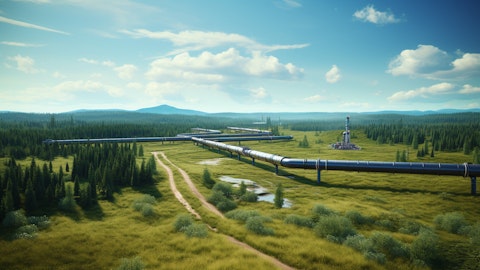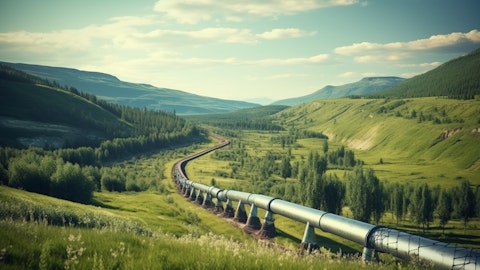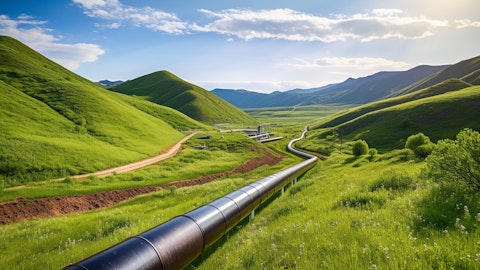Operator: Our next question will come from Theresa Chen with Barclays.
Theresa Chen: Quick follow-up related to the BANGL commentary if I may. Can you just help us walk through the economics behind the expansion and given that there seems to be quite a bit of Permian NGL capacity coming online between multiple projects, including yours — how do you view the evolution of rates over the next few years? Are you not really susceptible given the integrated strategy?
Shawn Lyon : Hey, Theresa, this is Shawn. Hey, good question. I think there’s been a lot of discussion about that. I’ll just really speak to again, our view of BANGL, of how, again, it’s really two things, the strength of the partners that really are driving the volume on BANGL and then also the capital efficiency. And we really feel we’re positioned to be really competitive in that market. So feel really good about that. Again, bringing on the expansion as the volume is there, we know it’s there. We’ve got the integrated win-win or value with our G&P business and other partners that are attached to BANGL. So we feel good about all those things that is driving it.
Mike Hennigan: Theresa, this is Mike. Can’t give you a lot of detail on the economics, but the capacity is there. So the capital investment is relatively low. We’re adding horsepower as an example. So this is an example of one of those projects where the amount of capital deployed is relatively low. And as Shawn mentioned, we have dedication, we know volumes are going to come. So it fits into what we call the higher return bucket compared to other type of investments. Hope that helps a little bit.
Theresa Chen: And then maybe turning to the residue side. So after Matterhorn begins service this year, there’s still a visible need for additional long-haul residue egress out of the basin, right? And thus far, none of the project vendor’s development have moved forward. When do you see residue takeaway becoming a problem for the basin? And given your interest in Whistler or Matterhorn, what do you view as MPLX’s role in the incremental build out of Permian residue capacity?
Dave Heppner: Hey, Theresa, this is Dave. So I’ll tackle that one. So you touched on a lot of it, and Shawn, and we have is, as you know we’re participating in those long-haul pipes, whether it be Whistler that came on originally in 3Q 2021, and then the expansion in September, 2023, whether be Matterhorn, which will be coming on in 3Q 2024, and subsequently ADCC, which coming on at the same timeframe. So all those are supporting our participating in the long-haul pipes and that value chain from basin down to the Gulf Coast. So, as we look forward, number one, we continue to see strong production forecast out of the Permian, which will continue to allow us to evaluate and analyze expansion projects or new projects going forward.
With all that said, maybe back to your question, based on our current forecast, we would expect to see after our projects come online that I referenced probably around the late ‘26, early ‘27 timeframe, the additional long-haul expansion capacity is going to be needed based on those forecasts. Hopefully that helps a little bit.
Mike Hennigan: Theresa, it’s Mike. I just wanted to add, aside from the Permian, I think the market is under appreciating the growth potential up in the Marcellus. It’s been talked about being in maintenance mode for some amount of time, but if you look recently there’s starting to be a growth spurt occurring up in that area as well. And I think if people look at it over time, eventually MVP will come online and it’s going to unlock some more growth. And I think, that’s another area that probably hasn’t been appreciated as much. But if you look over, even just the last year, the last couple quarters in our results in general the processing volumes have really kicked up compared to where they’ve been recently. So aside from the Permian growth, which gets a lot of attention, I think, the Marcellus and also the Utica, again, Utica was an area that probably was a little less thought of recently but it’s also starting to go into a growth mode as well.
I’ll let Greg give a couple comments on that. Because I don’t want people to miss that thought.
Greg Floerke : Yes, thanks Mike. This is Greg, Theresa. In terms of the volume that we process, little over 6 billion cubic feet a day, which is nearly 6% of the U.S. total gas is of the 9.5, that we process in total was in the Marcellus. And that wrote — that drove our utilization of our processing plant fleet up to 96%, which is a new record for us. All of that process gas generated a lot of C3 plus liquids in particular, so that drove our fractionation utilization up to 82% in growing. We have a unique integrated system in the Northeast that’s totally different than what we have in the Southwest, and that we have to fractionate our own liquids and then find outlets. Fortunately, we have outlets to the East Coast for export and as well as into the Midwest for our cornerstone pipeline, and we have access for gasoline into Canada, as well as butane into the Midwest.
So we have a really good position there and Harmon Creek II, coming online is much needed at the utilization point we’re at now. We’ve also — as Mike mentioned, brought our Utica utilization up to 49% and growing after a period of time where there wasn’t growth. And we see a lot of good tailwinds with new producers moving into Utica and new state land auctions coming up expected this year. And we have existing capacity, not only the processing plants, but fractionation and liquid and gas pipelines to fill. So that’s leveraging those existing assets and without a lot of new capital is a big focus for us.
Theresa Chen : Thank you for that detailed answer across multiple regions.
Operator: Our next question will come from Jeremy Tonet with JPMorgan.
Jeremy Tonet : Just wanted to touch base on the acquisition a little bit more if I could, if you’re able to share a bit more color on the JV interest acquired. Are these existing assets in the Permian or assets otherwise that are kind of, can be relocated to the Permian? And I guess, just thoughts on the type of synergies that could be captured here, what that could mean for economics?



